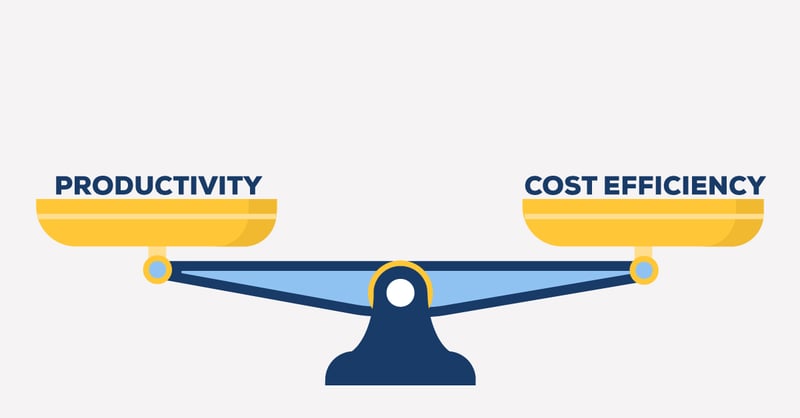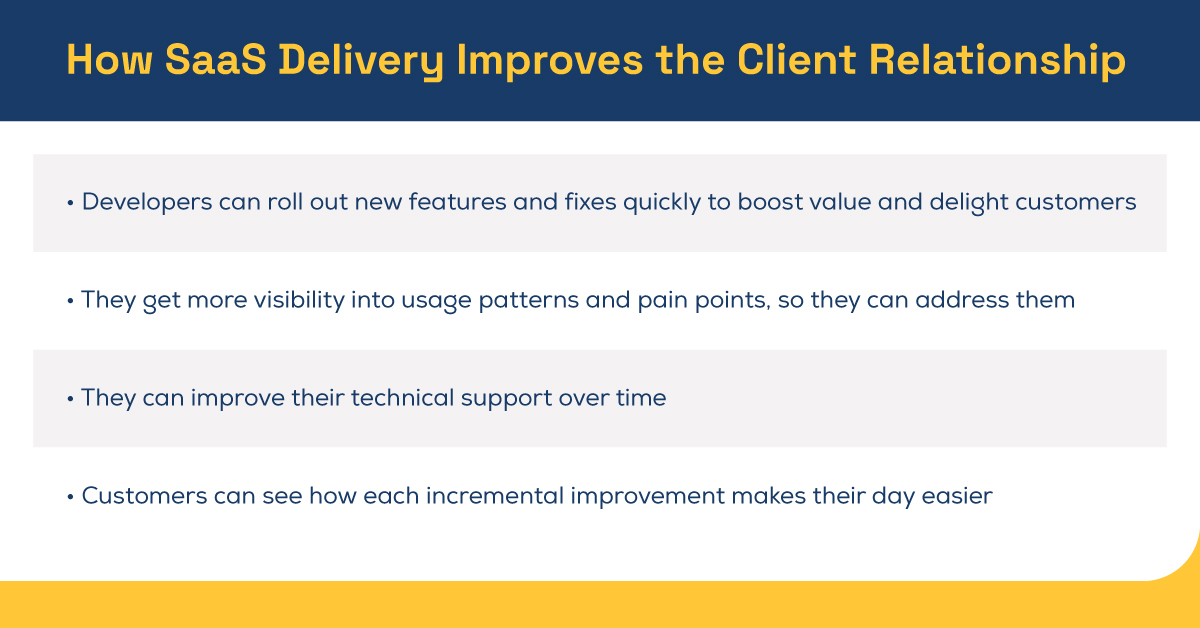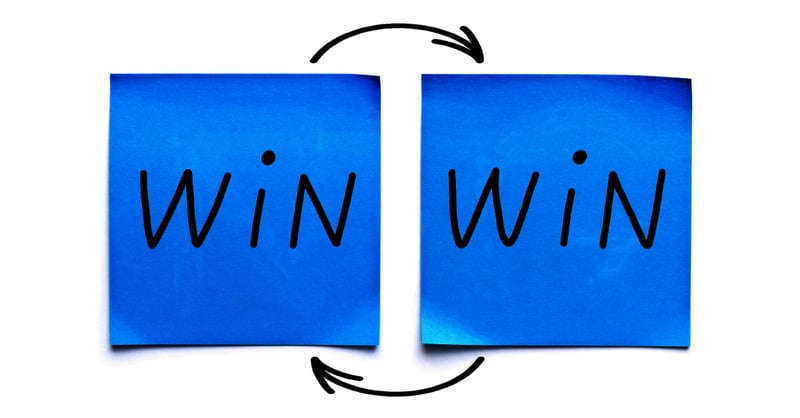Remember when software was a one-time buy, and you installed it through a CD drive? Good times. Now, software typically comes as a subscription, and it’s delivered through the cloud. Software as a Service (SaaS) first made a splash in 1999, when Salesforce launched its customer relationship management (CRM). Still, most people assumed SaaS solutions were only beneficial for small to midsize businesses and wouldn’t amount to much.
Oops.
Let’s walk through why that’s all changed…
Why Most Software Isn’t a One-Time Purchase Anymore

Hear us out on this one: Overall, it’s actually mutually beneficial for software developers and customers that software moves to a subscription model rather than a one-time purchase. We’ll get to that in a bit. But for now, here are the most common reasons software companies made the switch.
They Get Recurring Revenue
Let’s start off with the obvious one, shall we? Rather than a one-time purchase fee, subscriptions allow software companies to keep collecting revenue the longer a customer renews their subscription. The software developer gets more predictable revenue, and who wouldn’t like that?
It Reduces the Barrier for Entry
Business software can be expensive, and before the subscription model, the upfront costs could be difficult for small to midsize businesses. The subscription model eliminates that big lump sum payment and smooths out payments over time.
Deployment Is Much Faster
SaaS applications can be deployed quickly without the need for lengthy installation processes. This accelerated deployment time allows organizations to leverage the technology faster.
Subscriptions Offer More Flexibility
Needs change. With a software subscription, you can always cancel it when you’re not going to be using it and renew your subscription down the road. That’s nice for customers, but software developers often feel like it’s better for them in the long run because it builds loyalty.
What Are the Advantages and Disadvantages of Software Subscriptions for Businesses?

Now that we know why the software companies did it, here’s what it means for you…
5 Advantages of SaaS Solutions
Pivoting to a subscription model has plenty going for it. These advantages really take the sting out of those monthly fees.
1. Lower upfront costs
Moving from a big, upfront purchase to smaller monthly payments helps businesses streamline spending. It also helps newer businesses to conserve their cash flow and invest some funds elsewhere. And with any updates or enhancements included in the subscription, businesses get access to the latest and greatest — and most secure — versions without having to make additional purchases.
2. Easy to Scale Up or Down
A subscription-based software model will allow you to scale up easily — just adjust your service to include more users or features. You can also scale down in a few clicks. Growth is also a bit easier on your IT team, because there’s less need for on-premises infrastructure, and no one has to manually install software updates or patches.
3. Location Independent
Most subscription-based software is cloud-enabled, so employees can access it from anywhere, through any device. While that’s always been helpful for frequent travelers, sick days, and when severe weather threatens a commute, SaaS solutions allowed many businesses to operate almost seamlessly during the initial phase of the pandemic. While the economic toll of COVID-19 was still significant, it could have been so much worse.
4. Software Companies Have to Keep Earning Your Business
When we mentioned loyalty building as a reason software developers made the switch, was that a surprise? Let’s unpack this one a bit.

5. Cybersecurity Can Keep Up With Hackers
SaaS providers like Microsoft have invested a fortune in their security strategy, tools, processes, and testing in order to provide businesses with stronger defenses than any single customer could achieve. SaaS solutions also reduce the risks associated with securing endpoint devices and various on-prem infrastructure.
And while we hate to call this out, some users tend to drag their feet about following best practices, like requiring multi-factor authentication and enforcing strong password policies. SaaS providers are doing their part to nudge customers toward good cybersecurity hygiene and tend to make adoption much easier.
4 Disadvantages of SaaS Solutions

Pivoting to a monthly subscription has some drawbacks. Let’s get real…not everyone wants to keep paying for something they used to own outright.
1. Higher Long-Term Cost
Those initial software expenses are lower, but if you stick with the same tools, you’ll probably end up paying more for them in the long run. True, those tools will always be optimized, but optimization comes at a price.
2. Data Portability Challenges
Switching from one SaaS provider to another or migrating data from a SaaS application to an on-premises solution can be a challenge. This can lead to limiting an organization's flexibility in migrating to alternative solutions.
3. Performance & Reliability Concerns
Performance may be affected by factors such as the provider's server capacity, the number of users accessing the application simultaneously, and the geographical location of the data centers. Consequently, downtime or service outages can disrupt business operations, and the level of support provided by the SaaS vendor becomes crucial in such situations.
4. Saas Tech Support Still Needs Work
Not to paint SaaS providers with a broad brush, but many of them are not exactly known for their stellar support. They do know this, and they’re trying to improve. However, their entire business model is built around trying to create a super product. They’ll probably never be able to provide the support that end users really want, because they’re not an organization that’s built from the ground up on service.
Getting SaaS at Its Best
 There is a way to reduce the additional expense of SaaS delivery while dramatically improving the support you’ll receive.
There is a way to reduce the additional expense of SaaS delivery while dramatically improving the support you’ll receive.
Because SaaS providers aren’t built on service, and they know providing an excellent customer experience will affect their bottom line, they are actually hoping you’ll buy your business software from a provider instead. They hope for this so, so much that they typically make it cheaper for you to go through a technology provider like Marco instead of buying it directly from them. They still get to sell their software, which is what they do best, and tech support and customer service are shifted to someone who’s just fundamentally better at providing it.
You get a better experience and save money at the same time. And they get to invest their time and money in improving their product. They’re so serious about this that they also offer special certifications for providers to demonstrate that they can provide support that’s as good or better than the developer can. And not to name drop (okay, just a little), but we’re a Cisco Gold Certified Partner and a Microsoft partner with these special technical capabilities:
- Solutions Partner for Infrastructure (Azure)
- Solutions Partner for Data & AI (Azure)
- Solutions Partner for Digital & App Innovation (Azure)
- Solutions Partner for Modern Work
We also have formed strategic partnerships with many more top software providers and equipment manufacturers around the world, so we can always offer competitive pricing.
Learn more about how we take the hassle out of SaaS solutions by clicking the link below! 